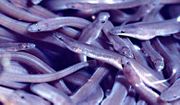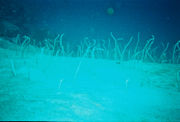| True eels |

American eel, Anguilla rostrata
|
|
Scientific classification |
|
|
| Suborders |
|
See text for suborders and families. |
True eels (Anguilliformes) are an
order of
fish, which consists of 4 suborders, 19 families, 110
genera and 400 species. Most eels are predators.
The flat and transparent
larva of the eel is called a leptocephalus. A young eel is called an elver.
Most eels prefer to dwell in shallow waters or hide at
the bottom layer of the ocean, sometimes in holes. Only the
Anguillidae family comes to fresh water to dwell there (not
to breed). Some eels dwell in deep water (in case of family
Synaphobranchidae, this comes to a depth of 4,000 m), or are
active swimmers (the family Nemichthyidae - to the depth of 500 m).
Biology
Description
Eels lack pelvic fins and the associated skeletal
structures. The pectoral fins (in those species that have
them) are midlateral in position and lack the posttemporal
bone, which connects the shoulder girdle to the skull. The
caudal and anal fins are long, usually connecting with the
tail (caudal) fin. The caudal fin lacks rays or may be
absent. The body is very elongated.
The number of rays of the gill webbing ranges from 6 to
51, though sometimes they are absent altogether. The scales
are
cycloid or absent.
Depending on their species, eels can reach from 10 cm to
3 m, and weigh up to 65 kg.
Life cycle
The life cycle of the eel was a mystery for a very long
time, because larval eels look very different from adult
eels, and were thought to be a separate species.
Classification

An eel from the genus
Gymnothorax

Juvenile
American eels

Garden eels
This classification follows
FishBase in dividing the eels into fifteen families.
Additional families that are included in other
classifications (notably ITIS and Systema Naturae 2000) are noted below the family with
which they are synomized in the FishBase system.
Suborders and families
Suborder
Anguilloidei
- Anguillidae (freshwater eels)
Chlopsidae (false morays)
Heterenchelyidae
Moringuidae (spaghetti eels)
Muraenidae (moray eels)
Myrocongridae
Suborder
Congroidei
-
Colocongridae
-
Congridae (congers)
- Including Macrocephenchelyidae
-
Derichthyidae (longneck eels)
- Including Nessorhamphidae
- Muraenesocidae (conger pikes)
Nettastomatidae (witch eels)
Ophichthidae (snake eels)
Suborder
Nemichthyoidei
- Nemichthyidae (snipe eels)
Serrivomeridae (sawtooth eels)
Suborder
Synaphobranchoidei
-
Synaphobranchidae (cutthroat eels)
- Including Dysommidae, Nettodaridae, and
Simenchelyidae
In some classifications the family Cyematidae of bobtail
snipe eels is included in the Anguilliformes,
but in the FishBase system that family is included in the
order
Saccopharyngiformes.
The so-called "Electric
Eel" of South America is not a true eel, but is more
closely related to the
Carp.
Use by humans
Freshwater eels (unagi) and marine eels (Conger
eel, anago) are commonly used in Japanese cuisine. Unadon is
a very popular but rather expensive food. Eels are used in
Cantonese and Shanghai cuisine too. The European eel and
other freshwater eels are eaten in Europe, the United
States, and other places around the world. A traditional
East London food is jellied eels. The Basque delicacy
angulas consists of deep-fried elvers.[1]
Other Information
In recent years, some
cryptozoologists have theorised that the Loch Ness Monster might be a giant eel (as was the case
in Steve Alten's novel The Loch, where the monster
was a giant Sargasso anguilla eel).
There is an urban legend that wallets made out of
electric eels will demagnetize your credit cards. This was
proven to be untrue in an episode of the Mythbusters TV
show. Actually, as pointed out in the Straight Dope, eel-skin wallets are made from
hagfish which are unrelated to electric eels.[2]
Furthermore, it seems that magnetic clasps, not eel leather,
are to blame for demagnetization.
Eel blood is toxic. The toxic protein it contains is
destroyed by cooking. The toxin derived from eel blood serum
was used by
Charles Robert Richet in his Nobel winning research which
discovered anaphylaxis (by injecting it into dogs and observing the
effect).
On January 31, 1930, the Danish research ship; "The
Dana", captured, (south of Africa's Cape of Good Hope), what
they thought at the time was a six-feet long eel larva. This
could have meant there were very long eels in the sea, since
the typical eel larva is three inches long, while the adults
can grow from about 4 feet to 16 feet long. In 1970, Dr.
David G. Smith from the University of Miami, identified the
larva found as that of the
spiny eel, an eel-like fish whose larvae length is equal
to its adult length, while the larvae length of the true eel
is much shorter than its adult length.
[3]
In
Micronesia, eels are believed to hold the souls of one's
departed relatives. As such, killing eels is a grave offence
and was once punishable by death.
References
-
"Anguilliformes".
FishBase. Ed. Ranier Froese and Daniel Pauly.
January 2006 version. N.p.: FishBase, 2006.




